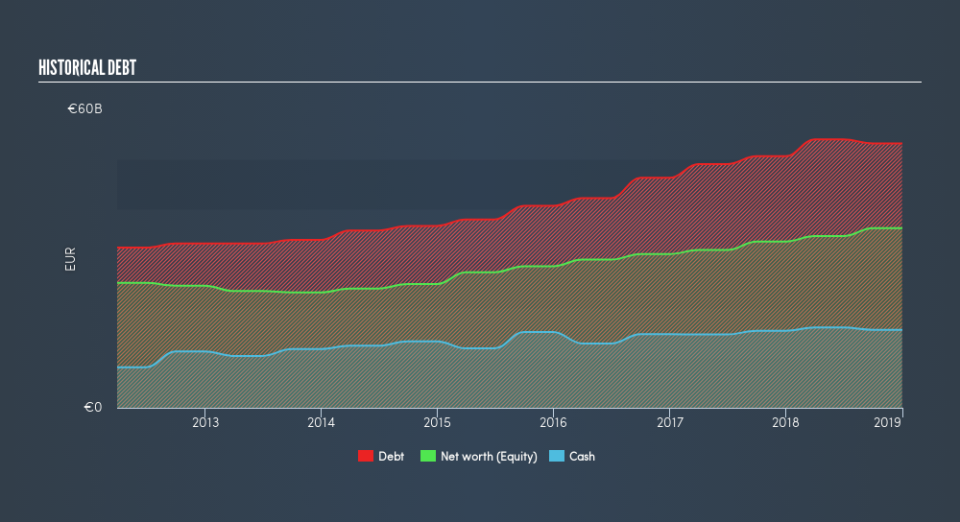How Financially Strong Is Renault SA (EPA:RNO)?

There are a number of reasons that attract investors towards large-cap companies such as Renault SA (EPA:RNO), with a market cap of €15b. Market participants who are conscious of risk tend to search for large firms, attracted by the prospect of varied revenue sources and strong returns on capital. But, the key to extending previous success is in the health of the company’s financials. I will provide an overview of Renault’s financial liquidity and leverage to give you an idea of Renault’s position to take advantage of potential acquisitions or comfortably endure future downturns. Remember this is a very top-level look that focuses exclusively on financial health, so I recommend a deeper analysis into RNO here.
View our latest analysis for Renault
Want to participate in a research study? Help shape the future of investing tools and earn a $60 gift card!
Does RNO Produce Much Cash Relative To Its Debt?
RNO’s debt levels surged from €51b to €53b over the last 12 months , which accounts for long term debt. With this increase in debt, RNO’s cash and short-term investments stands at €16b , ready to be used for running the business. Additionally, RNO has produced €6.3b in operating cash flow over the same time period, leading to an operating cash to total debt ratio of 12%, meaning that RNO’s debt is not covered by operating cash.
Can RNO meet its short-term obligations with the cash in hand?
Looking at RNO’s €68b in current liabilities, the company has been able to meet these obligations given the level of current assets of €70b, with a current ratio of 1.03x. The current ratio is the number you get when you divide current assets by current liabilities. Generally, for Auto companies, this is a reasonable ratio since there is a bit of a cash buffer without leaving too much capital in a low-return environment.
Is RNO’s debt level acceptable?
With total debt exceeding equities, Renault is considered a highly levered company. This is not unusual for large-caps since debt tends to be less expensive than equity because interest payments are tax deductible. Accordingly, large companies often have lower cost of capital due to easily obtained financing, providing an advantage over smaller companies. By measuring how many times RNO’s earnings can cover interest payments, we can evaluate whether its level of debt is sustainable or not. A company generating earnings before interest and tax (EBIT) at least three times its net interest payments is considered financially sound. In RNO’s case, the ratio of 16.4x suggests that interest is comfortably covered. Large-cap investments like RNO are often believed to be a safe investment due to their ability to pump out ample earnings multiple times its interest payments.
Next Steps:
RNO’s debt and cash flow levels indicate room for improvement. Its cash flow coverage of less than a quarter of debt means that operating efficiency could be an issue. However, the company exhibits an ability to meet its near-term obligations, which isn’t a big surprise for a large-cap. Keep in mind I haven’t considered other factors such as how RNO has been performing in the past. I suggest you continue to research Renault to get a better picture of the stock by looking at:
Future Outlook: What are well-informed industry analysts predicting for RNO’s future growth? Take a look at our free research report of analyst consensus for RNO’s outlook.
Valuation: What is RNO worth today? Is the stock undervalued, even when its growth outlook is factored into its intrinsic value? The intrinsic value infographic in our free research report helps visualize whether RNO is currently mispriced by the market.
Other High-Performing Stocks: Are there other stocks that provide better prospects with proven track records? Explore our free list of these great stocks here.
We aim to bring you long-term focused research analysis driven by fundamental data. Note that our analysis may not factor in the latest price-sensitive company announcements or qualitative material.
If you spot an error that warrants correction, please contact the editor at editorial-team@simplywallst.com. This article by Simply Wall St is general in nature. It does not constitute a recommendation to buy or sell any stock, and does not take account of your objectives, or your financial situation. Simply Wall St has no position in the stocks mentioned. Thank you for reading.

